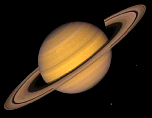Saturn
 Saturn has been known as a bright, mobile star since prehistory.
Its strange, shifting shape puzzled observers until Christiaan Huygens
proposed the idea that Saturn had a ring around it. This explained why
it appeared to have bumps or handles which disappeared at times (when
the rings were edge-on to the Earth).
Saturn has been known as a bright, mobile star since prehistory.
Its strange, shifting shape puzzled observers until Christiaan Huygens
proposed the idea that Saturn had a ring around it. This explained why
it appeared to have bumps or handles which disappeared at times (when
the rings were edge-on to the Earth).
Saturn is the second largest planet in the Solar System. Despite this, it has an overall specific gravity of� 0.7, which makes it less dense than water. This is due to the fact that Saturn is truly a gas giant. It has almost no rocky bits in its interior, only ice and gas. Like Jupiter, it has a middle of liquid metallic Hydrogen, and thus its own magnetic field. It also produces its own heat, again like Jupiter, radiating back more than the heat it gets from the Sun. Due to its gassy form, Saturn has been squashed noticeably by its own gravity. It is oblate.
|
Diameter |
120, 500 km |
|
Mass |
5.7 × 1026 kg |
|
Mean Distance from sun |
1,429,400,000 km |
|
Mean Density |
0.69 g/cm3 |
|
Rotational Period |
0.44 Earth days |
|
Orbital Period |
29.5 Earth years |
|
Mean Orbital Velocity |
9.67 km/s |
|
Atmosphere |
95% hydrogen, 5% helium |
|
Average Surface Temperature |
-125°C |
|
Equatorial Surface Gravity |
�8.96 m/s2 |
| Copyright owned by the State of Victoria (Department of Education and Early Childhood Development). Used with Permission. |
|
|||||||||||||||||||||||||||||||||||||||||||||||||||||||||||||||||||||||||||||||||||||